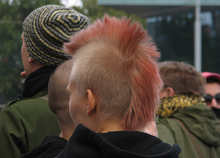Article
The portion of epidermis, or skin, that covers the dome of the human head, from the hairline above the brows back to the nape of the neck. In many cultures, historically the scalp has been harvested from slain enemies as proof of their death. Scalps can also be removed from living victims, who may or may not survive the process.
In curing ceremonials, such as the Navajo Enemy Way, the scalp referenced in some versions of the ceremony is actually a token object representing an enemy. The Enemy Way is a ceremony performed to cure people from illness caused by coming into contact with an "enemy," typically someone or an experience outside the Navajo culture and traditional lifeways. The symbolic scalp is collected during a ritualized warpath during the ceremony, brought to the place of healing without being touched, and kept out of sight until it is time to be destroyed.
"Mohawk, Etu-Toolo, Helsinki, Uusimaa, September 21, 2013" by Oona Räisänen is licensed under CC BY-SA.
Manuscripts
A01 The Blessing Way (01-07) p. 89
A01 The Blessing Way (01-07) p. 93
A01 The Blessing Way (01-07) p. 98
A01 The Blessing Way (01-07) p. 100
A01 The Blessing Way (01-07) p. 112
A01 The Blessing Way (01-07) p. 114
A01 The Blessing Way (01-07) p. 115
A01 The Blessing Way (01-07) p. 121
A01 The Blessing Way (01-07) p. 122
A01 The Blessing Way (01-07) p. 123
References
Frisbie, Charlotte Johnson
1980 Approach to the Ethnography of Navajo Ceremonial Performance. Ethnography of
Musical Performance, Norma Mcleod and Marcia Herndon, eds. Norwood: Norwood
Editions.
Haile, Berard
1943 Origin Legend of the Navaho Flintway. Chicago: The University of Chicago Press.
Hirschfelder, Arlene, and Paulette Molin
2000 Evil Way. Encyclopedia of Native American Religions, Updated Edition. New York:
Facts On File, Inc.
Mitchell, Frank
1978 Navajo Blessingway Singer: The Autobiography of Frank Mitchell, 1881-1967. Tucson:
University Of Arizona Press.
Witherspoon, Gary
1975 Navajo Kinship and Marriage. Chicago: University of Chicago Press.

